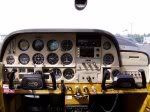Monday, January 03, 2005
01/03/2004
On a rainy Saturday morning last year, I collected my Cardinal research materials, hopped in the car, and headed east from Westfield. This was the second expedition in my search for a Cessna Cardinal. My quarry this time was a 177B advertised by a dealer at an airport near Cape Cod. Three hours later, I met Steve in his office in the small terminal. He was kindly older gentleman, the kind you sometimes find at small airports, and he had the air about him of someone who had spent most of his life around airplanes. Dodging the ice still in the parking lot, we climbed into his car for the short drive out to the ramp where the Cardinal awaited.She sat quietly in the cold drizzle, a basically stock 177B, with original paint and interior. The 30 year old paint was in fairly good condition, but showing some chips and weathering. A walk around her showed nothing obviously amiss, a noticeable difference from the Cardinal I had looked at two days ago. Inside, the carpet was worn, but still whole, The seats were in decent shape, but some of the interior plastic trim pieces were brittle with age and cracked.
 The interior colors were a combination of caramel brown and off-white, with a little bit of imitation wood trim on the doors. It was dated, but tasteful, at least by mid 1970's standards.
The interior colors were a combination of caramel brown and off-white, with a little bit of imitation wood trim on the doors. It was dated, but tasteful, at least by mid 1970's standards.  The instrument panel had changed little since she was first built. The two original navigation/communication radios had been replaced with more modern digital units, but the rest of the avionics were the factory standard ARC items. She had a basic single-axis autopilot, but no advanced navigation components such as GPS or Loran. A digital chronometer was the only real addition to what was essentially a stock panel.
The instrument panel had changed little since she was first built. The two original navigation/communication radios had been replaced with more modern digital units, but the rest of the avionics were the factory standard ARC items. She had a basic single-axis autopilot, but no advanced navigation components such as GPS or Loran. A digital chronometer was the only real addition to what was essentially a stock panel.After a few more minutes of examination, we headed back to the warmth of Steve's office to have a look through the maintenance logs. Faithful Instructor George had walked me through the logs of his Skyhawk in preparation for the oral exam portion of my private pilot's checkride, so I knew how to find the essential entries, but I was still a neophyte when it came to judging an airplane's maintenance history. Fortunately, the logs were clearly written and easily read. A steady succession of annual inspections and oil changes progressed though the pages, dating from the first 25, 50, and 100 hour inspections when she was new back in the early 1970's up until her most recent annual inspection. For the last decade at least, she had been cared for by the same mechanic, working out of the maintenance shop on the field where she now lived. Periodically, various items had been replaced as they wore out, but there was no record of any major mechanical failures. The only unusual entry concerned a hard landing in the early 1991's that had warranted replacing the nose wheel. She appeared to have been flown regularly, but her airframe was still young in hourly terms. Her engine had been overhauled by a reputable shop only two years ago.
My impression was of an airplane that hade been well cared for mechanically. She appeared healthy to the eye of a new pilot like me. True, she was showing her age, but the important thing to me was there was no indication of abuse or neglect.
Military NCO's conducting an inspection of the troops will learn to evaluate a soldier's uniform at first glance. If the obvious items are in shape, it's a good chance that the minor details have been attended to as well. But if even one minor discrepancy shows - a button undone or a thread hanging loose from the corner of a pocket - then the offending soldier is in for a much closer look and it's a good bet that he'll be spending his liberty time scrubbing floors or peeling potatoes. When I saw my first Cardinal, I was immediately struck by several obvious flaws that hinted that she had not received the best of care. Today's Cardinal told a different story. If the logs noted that a rivet had been replace on the upper cowling, the rivet in question was indistinguishable to my eye from its neighbors installed at the factory. If that much care had been taken for one rivet, I was much more confident that the rest of the airplane had been treated just as well.
I expressed my interest to Steve, and we made tentative plans for me to take her up for a demo flight once the weather improved. She was the second Cardinal I had met, and she was already in first place, but there was yet another one to be seen...

Howdy, you're off to a great start. I'm a member of the Chandelle Flying Club at KAUS ( www.chandelleflyingclub.com ) which operates C-177RG N8035G. It's a great plane, nothing does more with 200hp than a Cardinal RG!
You might check your blog with Firefox, some of your text is garbled. It's a pity since your site is very pretty otherwise. I love the little Cardinal streaking across the bottom.
Jim Howard
Jim, thanks for the Firefox tip. I think I've found and fixed the problem.
Very nice, I fly a '68 and it doesn't have problems, just quirks. With a 180hp conversion it rocks!